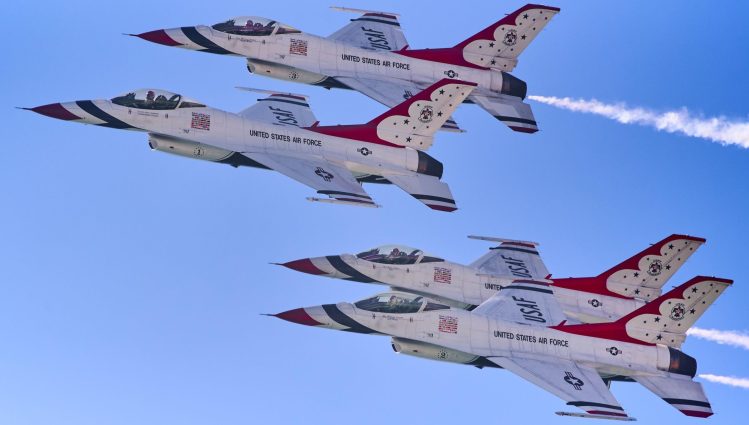Who doesn’t love a good airshow? One of my first airshow memories is watching the US Air Force Thunderbirds roar across the sky. At that point, I wanted to be a fighter pilot. Turns out Uncle Sam had different plans for me, but I still love watching precision aviation demonstrations.
Let’s learn a little bit about these high-speed precision pilots.
The United States Air Force Thunderbirds are more than just an aerial demonstration team; they are the epitome of precision, skill, and patriotism. Formed in 1953, the Thunderbirds have captivated audiences worldwide with their stunning aerobatic displays, showcasing the prowess and dedication of the United States Air Force.
Origins and History
The Thunderbirds were established at Luke Air Force Base in Arizona with the aim of promoting public understanding and support for the Air Force’s role in national defense. Named after the mythological Native American creature, the team symbolizes power, strength, and grace—attributes reflected in their performances.
Initially flying the F-84G Thunderjet, the team has transitioned through various aircraft over the decades, including the F-100 Super Sabre, F-4 Phantom II, T-38 Talon, and currently, the F-16 Fighting Falcon. Each aircraft brought new capabilities and challenges, pushing the Thunderbirds to continually refine their skills and routines.
Training and Precision
Becoming a Thunderbird pilot is no small feat. Members are selected from the best of the best within the Air Force, undergoing rigorous training and evaluation. The team’s intense schedule demands precision, with maneuvers performed at high speeds and close proximities. Trust and teamwork are paramount, as pilots rely on each other’s exact movements to maintain formation and ensure safety.
The iconic diamond formation, solo passes, and opposing passes are just a few of the thrilling maneuvers that leave audiences in awe. Each show is meticulously planned and executed, a testament to the Thunderbirds’ dedication to excellence.
Mission and Impact
Beyond their aerial prowess, the Thunderbirds serve as ambassadors for the U.S. Air Force, fostering a positive image and inspiring future generations of aviators. They participate in air shows across the United States and abroad, demonstrating the capabilities of the Air Force and the professionalism of its personnel.
The Thunderbirds also engage in community outreach, visiting schools and hospitals and meeting with veterans. Their presence at these events highlights the Air Force’s commitment to service and community, reinforcing the values of integrity, service, and excellence.
Modern-Day Thunderbirds
Today, the Thunderbirds continue to evolve, incorporating new technology and techniques to enhance their performances. The F-16 Fighting Falcon, with its advanced avionics and maneuverability, allows for more dynamic and complex routines, thrilling audiences with every display.
The team’s dedication to innovation and excellence ensures that each performance is not only a testament to their skills but also a tribute to the rich history of military aviation. The Thunderbirds stand as a symbol of the United States Air Force’s strength, agility, and unwavering commitment to defending freedom.
Conclusion
The USAF Thunderbirds are more than an aerial demonstration team; they are a living legacy of the Air Force’s dedication to precision, excellence, and service. From their humble beginnings in 1953 to their modern-day performances, the Thunderbirds have continually inspired and captivated audiences around the world. Their breathtaking displays remind us of the skill, teamwork, and dedication required to protect and serve the nation.
As they continue to push the boundaries of aerial demonstration, the Thunderbirds exemplify the spirit of the United States Air Force, soaring high with pride, precision, and a relentless pursuit of excellence.
—
Disclaimer: SOFREP utilizes AI for image generation and article research. Occasionally, it’s like handing a chimpanzee the keys to your liquor cabinet. It’s not always perfect and if a mistake is made, we own up to it full stop. In a world where information comes at us in tidal waves, it is an important tool that helps us sift through the brass for live rounds.



